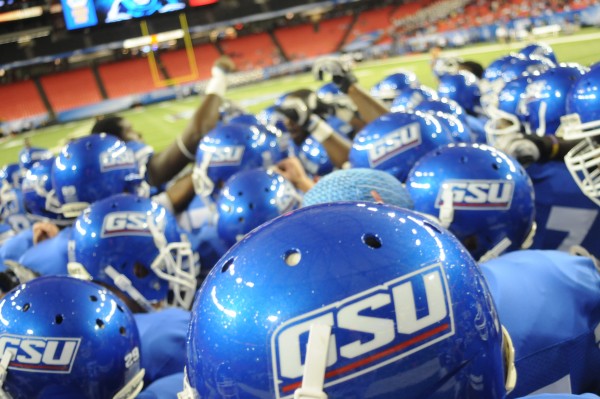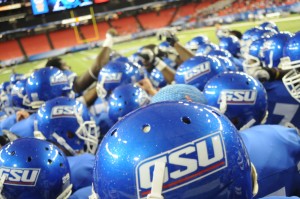

As the summer comes to a close, it means the beginning for quite a few things. The start of school, the start of cooler weather, and arguably most exciting of all, the start of another football season. Coming off the heels of their most successful season to date that was capped off by their first ever bowl appearance, Georgia State returned to summer training with a lot to prove, specifically one position group more than others.
Many believe that position group would be the quarterback; a trio of redshirt sophomore Emiere Scaife, graduate transfer Conner Manning, and redshirt freshman Aaron Winchester all are fighting for the opportunity to replace the reigning Sun Belt Student-Athlete of the Year.
In reality, that position group is the running backs, a group marked by inconsistent play last season.
The Panthers rushed for 1,263 yards last season, but that was overshadowed by their opponents registering over 1,000 more yards on them during the same course. They only averaged 96 yards per game, recorded only 70 rushing first downs, and keep in mind their opponents nearly doubled them in both of those categories. Couple in the fact they lost more rushing yards over the season than their opponents did and they only scored 15 touchdowns against 18 rushing touchdowns allowed on the opposite end.
Oh yeah, over a third of those rushing touchdowns belonged to a quarterback.
The inconsistency could be attributed to a couple of factors, but none more so than injuries and depth. The injuries took their toll on Georgia State by midseason. By game six, multiple backs had already missed time. The team’s second-leading rusher, Kyler Neal, missed two games with a knee injury that looked worse than it was and Taz Bateman had broken his arm rendering him to miss six games. The lack of available bodies forced the Panthers to make a wide receiver their new ball carrier. Gladly that’s not an issue Georgia State should face this season.
“Last year we didn’t have the numbers that we do this year so if someone goes down, someone else will have to step up,” said Coach Reid. “That’s the biggest difference from last year, the numbers bring competition, and that makes everyone better.”
The numbers definitely should not be an issue for the Panthers this season as they have a field of up to seven guys competing including Kyler Neal, and leading overall rusher, Glenn Smith, who also echoed similar sentiments.
“Last year we didn’t have a lot of depth,” said Smith. “Depth is the biggest thing I see this year, and that’s good.”
Smith was the wideout moved midseason to running back due to injuries. The decision would undoubtedly end up a good one as Smith would end up as Georgia State’s leading rusher with 356 yards averaging just over four yards per carry. Along with Smith, redshirt junior Kendrick Dorn, redshirt freshman Demarcus Kirk, and the healthy return of Neal, the Panthers have a wealth of options with experience.
To go along with all the experience the Panthers are returning they are also bringing in a new crop of freshman backs. Darius Stubbs, Tra Barnette, and Deandre Bowman were all solid high school backs who are looking to come in and compete for playing time right away. Barnette and Bowman are both 5’10, 180-pound backs, Bowman from Pacelli High in Columbus, Georgia and Barnette hailing from Elberton High in Elbert, Georgia. Stubbs is also 5’10, but slightly bigger at 200 pounds; he’s been making noise all summer and as of now looks like the freshman back most ready to play right away.
The running back being one of the weaker positions for the football program is good news for the incoming freshman, and Bournette spoke on what it feels like to come into a pretty open position battle.
“It gives me a little bit of comfort, but not too much,” said Bournette. “There are still a lot of great running backs out here, so every day I still got to come out and compete.”
He also spoke of the differences he has been noticing between high school and college ball.
“Speed. The speed is way faster and here, a lot quicker than high school,” Bournette said. “The players are bigger and strong here too.”
Coach Miles has already explained the team is planning on using a committee approach to the running game this year. With all the talent coming in and returning, that might be the wisest option. It will preserve some of the players, hopefully limiting injuries and injury opportunities, and it will give playing opportunity to more players, which is especially good news to the freshman and others who are trying to crack the rotation.
All in all, the running game has the potential to be a vast improvement from last year. Stronger depth field plays the biggest part in it, but also the experience of winning and the motivation to keep on winning. If the passing game can hold up from what it was last year or at least not drop off too radically, with an improved run game this offense could be one of the best in the Sun Belt, and that is a sentiment both coaches and players believe.
“I feel like if we can run the ball successfully this year, we should be fairly good as an offense,” said coach Reid. “We are gonna’ be using a running back by committee, whatever is gonna’ help us, that’s what’s most important, winning.”
With a mindset like that radiating from the coach, it is going to trickle down to the players.
They know they need to be better than last year.
They know their teammates and coaches need them to be better than last year.
And they plan to be.
With an already capable defense and accomplished wideouts, an improved running game could be the missing piece.
And the running backs are eager to complete that puzzle.
